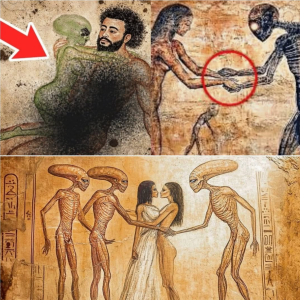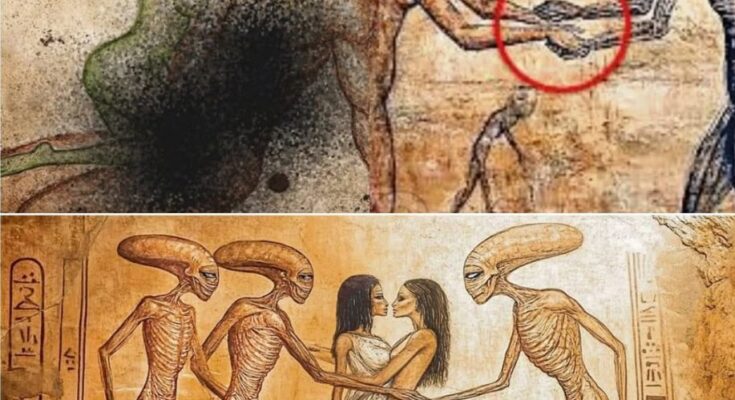Ancient Whispers and Extraterrestrial Unions: A Modern Exploration of Age and Relationships
For millennia, humanity has gazed at the stars, captivated by the possibility of life beyond our planet. From the enigmatic cave paintings of our ancestors to the sophisticated digital art of today, depictions of human interaction with otherworldly beings continue to stir our imaginations, sparking a blend of awe, curiosity, and perhaps a touch of apprehension. The striking images you shared—modern interpretations styled as ancient murals depicting humanoids alongside extraterrestrial figures—perfectly encapsulate this enduring fascination. These artistic creations aren’t merely pretty pictures; they’re powerful visual prompts, pushing us to delve into the deeper questions they subtly pose: Have we always subconsciously felt a connection to the unknown? And how do concepts like partnership, unity, and age differences factor into these age-old narratives?
Myth, Mythology, and the Cosmos: Exploring Ancient Beliefs
Ancient Tales of Celestial Encounters
Countless ancient cultures wove tales of gods or cosmic entities descending to Earth, interacting with humanity. From the Sumerian myths of the Anunnaki to the powerful otherworldly figures portrayed in ancient Egyptian art, and even the more contemporary “ancient astronaut theory,” these narratives reflect our persistent yearning to understand our origins and our place within the vast cosmos. The artwork you provided expertly plays upon this rich tapestry of myth and legend, appearing ancient yet undeniably modern, strategically designed to ignite a discussion about human-alien contact, the complexities of love, and the potential for unity across vastly different forms of existence.
The Age Question: Biblical Perspectives and Modern Interpretations
Age Gaps in Relationships: A Biblical Perspective?
The images also raise the intriguing question of age differences in relationships. Many individuals search for guidance on ideal age gaps within sacred texts like the Bible. However, a careful examination reveals that the Bible doesn’t explicitly dictate an ideal age difference for marriage. Instead, biblical marital unions frequently mirrored the social norms of their time, where significant age disparities were common and socially acceptable. For example, the patriarch Abraham was considerably older than his wife Sarah (Genesis 17:17 highlights a ten-year difference). Crucially, these age differences weren’t presented as moral guidelines but rather as reflections of the prevailing societal structures.

Beyond the Numbers: The Essence of a Successful Union
The Bible, more importantly, emphasizes enduring values that transcend age: unwavering love, steadfast faithfulness, profound respect, and a mutual commitment to the partnership. Ephesians 5:25 eloquently instructs husbands to “love your wives, just as Christ loved the church and gave himself up for her,” while 1 Corinthians 13:4-7 paints a vivid picture of love as patient, kind, and enduring. These qualities far outweigh the simple numerical difference in years between two individuals.
Bridging the Divide: Unity Across Differences
Returning to the evocative artwork, the depiction of humans and aliens united in these scenes serves as a potent symbol of unity in the face of profound difference—whether that difference lies in age, cultural background, or even species. These artistic representations challenge us to consider what truly unites us across seemingly insurmountable divides. Is it a shared sense of purpose, mutual care, or something even more profound and cosmic in nature?
The Universal Yearning for Connection
Ultimately, both ancient narratives and modern artistic expressions reflect our innate desire to bridge gaps: to reconcile the young and the old, the familiar and the foreign, the human and the other. The underlying message of the Bible, and perhaps the deeper message embedded within these thought-provoking artistic depictions, is a call to focus on the heart, character, and spirit of a partnership rather than superficial external differences like age. It is a testament to the universal human yearning for genuine connection, regardless of the perceived boundaries we construct between ourselves and others. The images serve as a potent reminder of this enduring truth.



